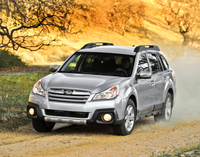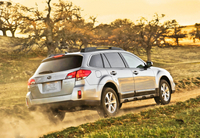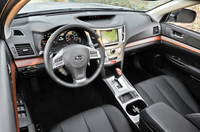The 2014 Subaru Outback Joins the AWD 30 MPG Club
In our northwest corner of the country, motorists embraced Subarus back when quirky wasn’t hip. We thought Subarus were neat long before Paul Hogan started hauling his “barbie” around in Outbacks or Lance Armstrong cycled his way to becoming the new company spokesman.
We, along with buyers in New England and the Rocky Mountain states, knew for years that Subaru’s all-wheel drive cars and wagons offered superior traction — not just on snowy roads, but on any slippery or uneven surface.
And the decision in 1994 to morph the Legacy wagon into the “world’s first sport-utility wagon” and call it Outback? Brilliant, as consumers in all three markets flocked to dealers.

Over the years Outbacks, and indeed, all Subarus, were known for just so-so fuel economy. The automaker has been working to erase that reputation, and the 2014 Outback earns inclusion in our All-Wheel Drive 30 MPG Club. The mainstream 2.5i model has an EPA estimated 30 mpg highway/24 mpg city and a combined rating of 26 mpg when equipped with a continuous variable transmission (CVT). Choose the manual shifter and fuel economy drops to 29/22 highway/city and 24 combined.
For those willing to forgo some fuel economy in exchange for power, the six-cylinder 3.6R limited is rated at 25/17 highway/city and 20 combined.
A Distinctive Look
The Outback has grown in size over the years and along the way became a nameplate of its own, losing the Legacy badge in 2000. But one thing hasn’t changed, its distinctive look.

In profile, it is still one handsome station wagon with a roofline that sweeps back naturally. Like the original, the SUV-like appearance is maintained with pronounced front and rear fender arches along with body cladding on the doors and rocker panels. The 8.7-inches of ground clearance continues to set it apart from other small crossovers.
A roof rack is still standard but with a clever twist. The roof rail system has noise-reducing crossbars that swing out of the way when not in use. It also makes it easier to secure bikes, kayaks and snowboards.
Inner Space
The dash, center console and door panels flow together in a contemporary manner. Materials look and feel rich, and the faux wood trim has a matte finish, not the sheeny look that so many makers prefer.
Unlike far too many vehicles that use tiny controls on the center console, the Outback has large, easy-to-read push selectors for climate control. And kudos to the designer who kept separate rotary audio control knobs rather than absorbing them into the navigation system.
Front bucket seats are supportive with good grip, yet are comfortable. And it’s easy to arrange a just-so driving position, which is a separate issue from how good the seats themselves feel. Front head- and legroom are excellent.

The rear cabin is a pleasing place to ride. It’s not only comfortable for adults with its reclining seatbacks, it’s a rear seat that adults can climb into without much trouble.
I’m still amazed by the amount of stuff you can cram into the cargo area of the Outback. There’s a generous 34.3 feet of storage space behind the rear seats, which expand to a voluminous 71.3 cubic feet with the seatbacks folded flat.
If you want a variety of choices, go no farther. There are six trim levels of the Outback wagon. Pricing begins at $24,230 including $825 destination charges for the base 2.5i with a 2.5-liter four-cylinder engine and manual transmission. Chosing the continuously variable transmission adds $1,000. The top 3.6 R Limited model starts at $32,920.
Committed To AWD And The Boxer Engine
Subaru introduced its first all-wheel drive vehicle in 1972, the Leone Estate. Called symmetrical all-wheel drive, the system became standard on all Subarus sold in U.S 1996. The lone exception is the rear wheel-drive BRZ sports car.
Engineers have improved the AWD technology over the years and today the system enhances traction, control and balance. What hasn’t changed is its symmetry — a balanced front-to-rear and side-to-side operation.
There are four different symmetrical AWD systems, depending on engine and transmission combinations.
While others have followed Subaru with AWD, it continues to march to its own drummer with its “boxer” engine. The boxer, also used by Porsche, is laid out horizontally rather than vertically, as are conventional in-line and V-engines. The pistons are placed opposite one another, and when the engine is running, it looks like a boxer throwing punches, hence the name.
This piston action allows their movement to cancel out vibration as well as reducing wear. And because it is mounted longitudinally — front-to-rear — it provides a low center of gravity, adding to the Outback’s sticking-to-road capability.
Behind The Steering Wheel
Subaru handed us the keys to an Outback 2.5i Limited to test drive. In addition to the CVT, standard equipment included leather upholstery with heated front seats, heated mirrors, dual-zone automatic climate control and a Harmon Kardon 400-watt audio system that featured hands-free BlueTooth audio and phone along with USB and iPhone ports. Suggested retail was $30,800.

Add to that an option package that bundled special 17-inch wheels, keyless access and start, moonroof, rearview camera, navigation system and Subaru’s EyeSight driver assist system along with other goodies. Total sticker price: $35,260.
A word about EyeSight. The system integrates adaptive cruise control, pre-collision braking and lane departure warning. It uses a stereo camera mounted on the inside of the windshield in front of the rearview mirror, and works exceptionally well except when weather conditions, such as heavy rain or snow, obscures the camera’s view.
Weighing in at close to 3,400 pounds, the 173-horsepower four-cylinder is no screamer. It has to work a bit, but it is more than adequate for the tasks we ask vehicles to perform. The payoff is the fuel economy for a vehicle this weighty that totes around an all-wheel drive system.
On paved surfaces, where the Outback spends most of its time, the ride is well isolated with a suspension that’s slightly firm around town, but generally very comfortable. Highway driving has an impressive sedan-like feel, in part because of the low center of gravity.
Steering works well, staying pointed straight ahead without fussing, when that’s your intent. Cornering is easily handled without slop or drama, courtesy of well-matched tires, suspension and AWD. Brakes come on swiftly when summoned, but no one will think they are touchy.
Subaru was an early adopter of the CVT transmission and the one in Outback is as good as they get. There was no annoying run up of engine rpms during heavy throttle application, and simulated gear shifts via paddle shifters resulted in smooth up and down shifts.
I first drove an Outback off-road in 1995, its first model year, when it was known as the Legacy Outback. At Subaru’s request, it was a support vehicle for the second annual “Mudfest,” an event judged by journalists to determine the Northwest Sport-Utility Vehicle of the Year.
Since then I have driven a score of Outbacks off-road. It probably can’t conquer the most rugged routes of the famed Rubicon Trail, but I’ve slogged miles behind Jeep Wranglers and Cherokees, Chevy Trailblazers and original Nissan Pathfinders on some very nasty, rutted, muddy, steep trails and emerged with nary a problem.
My off-road foray with this Outback wasn’t a real test, just a few miles on an old, neglected Forest Service road for a picnic by a scenic stream.
As for fuel economy, the Outback delivered as advertised. Driving most of the time at the legal go-with-the flow pace for 251 miles rewarded us with a 28.9-mpg average, nearly 3 mpg better than the EPA combined estimate. That included nearly 35 miles of some frisky driving on a nearly deserted two-lane country road.
A New 2015 Outback Is Arriving
As you read this, a new 2015 Outback is beginning to arrive at Subaru dealerships. It trades a bit of its rugged appearance for a more sporty appearance, is marginally larger inside, but does offer slightly better fuel economy. As with any new model, there’s a price hike. In this case, the base 2.5i with CVT (the manual shifter isn’t available) jumps less than $500 to $25,745.
If you’ve considering an Outback, the question is, should you buy the new 2015 edition, or opt for the outgoing model?
My youngest son decided to buy the 2014 model, his second Outback. His reason? Price. Dealers still have a fair number of 2014 Outbacks on their lots and want to move the inventory. He not only took advantage of an exceptional closeout price, he also got 1.9 percent financing. For him, that outweighed the slightly larger interior room and small increase in fuel economy.
What’s your decision?

3 thoughts on “Road Test: 2014 Subaru Outback”